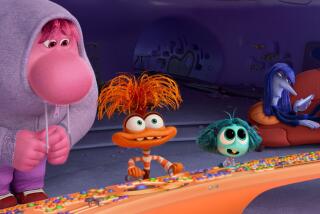PERSPECTIVE ON ENTERTAINMENT : The Long Arm of What You Watch : It’s not the copycat crimes that should alarm us but the incremental, subliminal definitions of base behavior as normal.
- Share via
In the past few days, Americans have seen chilling confirmation of the powerful impact that fanciful images in the popular culture exert on everyday life.
No, I’m not talking about the case of a torched toll booth in the New York subway, apparently in imitation of a scene in the current film, “Money Train.” I’m referring to the ubiquitous toy commercials that turn up everywhere this time of year and make their influence felt in every home with kids and a TV. No matter how young they are, children have a distressing tendency to point to some glitzy gizmo fetchingly displayed on the family tube and to demand, in tones too insistent to be safely ignored, “I want it!”
Television is a medium so potent that it can implant these ardent imperatives in the minds of our kids in the course of a 30-second ad. How can we then pretend that it will fail, over the course of hours and hours of irresponsible programming, to instill other urgent and unwelcome yearnings?
Both critics of the entertainment industry and apologists for the Hollywood establishment have recently spent too much time debating the significance of the subway torching and other copycat crimes. The most profound problem with the popular culture isn’t its immediate impact on a few vulnerable and explosive individuals, but its long-term influence on all the rest of us. The deepest concerns about Hollywood go beyond the industry’s role in provoking a handful of specific and horrifying incidents. They involve its contributions to a general climate of violence, fear, impatience and self-indulgence.
Defenders of violent TV and movies are unquestionably correct in pointing out that the overwhelming majority of people who view such material never directly imitate what they see on screen. But this doesn’t mean they remain altogether unaffected by the gratuitously brutal scenes included in so much of American entertainment.
Consider, once again, the example of television commercials. Only a tiny fraction of those who watch a Lexus ad will ever go out and buy the car. Does that prove that the auto company has wasted the millions it spent on these ads, or that the public hasn’t been influenced in any way by the elegant and seductive images so painstakingly prepared by the advertising agency? Of course not. Even those who will never come close to buying a Lexus are affected by the commercial, which, after repeated viewings, defines the vehicle as a desirable symbol of status and power and good taste.
In the same sense, the entertainment industry’s constant depiction of violent and destructive behavior, as perpetrated by some of the most attractive and glamorous human beings on the planet, redefines such conduct as sexy, glamorous, even admirable. We may not instantly copy dangerous or despicable actions we view in movies or on TV, but that doesn’t indicate that media images are powerless to alter our notions of what is acceptable--or fashionable--in the world around us. Watch the way that children in particular will subtly, sometimes unconsciously, pattern their speech or dress or hairstyles after favorite figures in the popular culture. It’s absurd to suggest that such influence will end in every case at the most superficial level.
This recognition hardly suggests that censorship is an appropriate remedy. Few commentators or political figures--no, not even Sen. Bob Dole--advocate government restrictions on the right of Hollywood’s creative community to produce even the most tawdry trash.
One can agree with the notion that movie makers have a perfect right to produce films glorifying, say, the rape and mutilation of young women at the same time that one argues that they have a responsibility not to do so.
There is no shortage of positive material in Hollywood; the Writers’ Guild registers 27,000 new screenplays every year. In deciding which few of these projects will get made and which won’t, the studios appropriately ask two basic questions: Will it make money? Does it have artistic value?
Executives should add a third fundamental question to the equation: What will be the impact of this proposed entertainment on the society in which we live? If Hollywood’s leaders explore this dimension of their work more fully, more consistently and more responsibly, they will begin to win back some of the trust of an increasingly hostile and suspicious public.
More to Read
The biggest entertainment stories
Get our big stories about Hollywood, film, television, music, arts, culture and more right in your inbox as soon as they publish.
You may occasionally receive promotional content from the Los Angeles Times.










